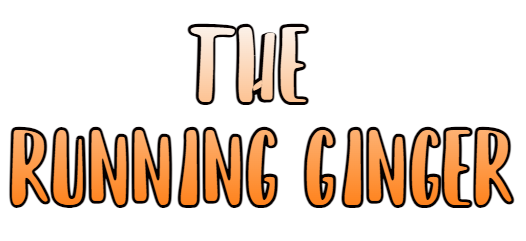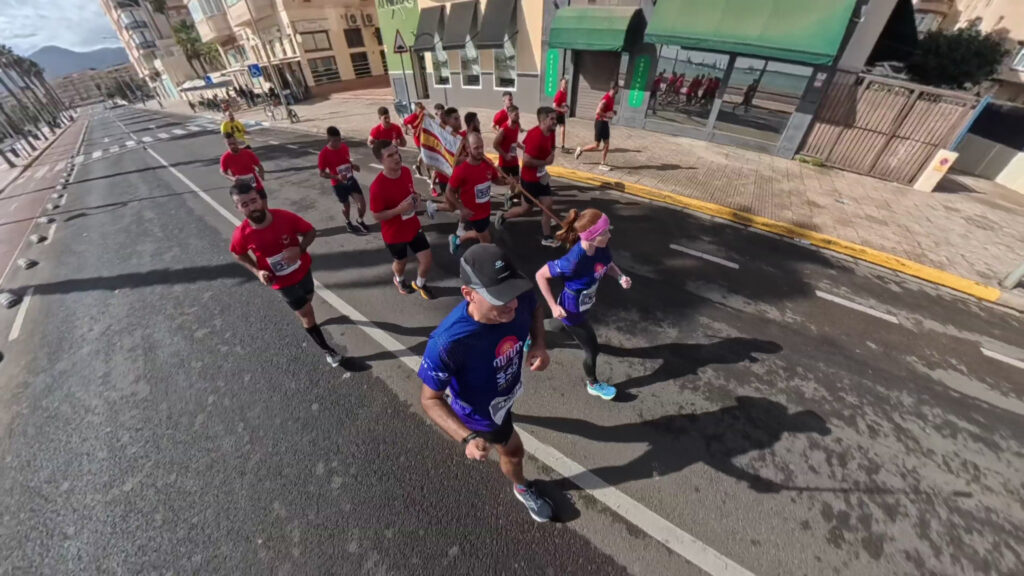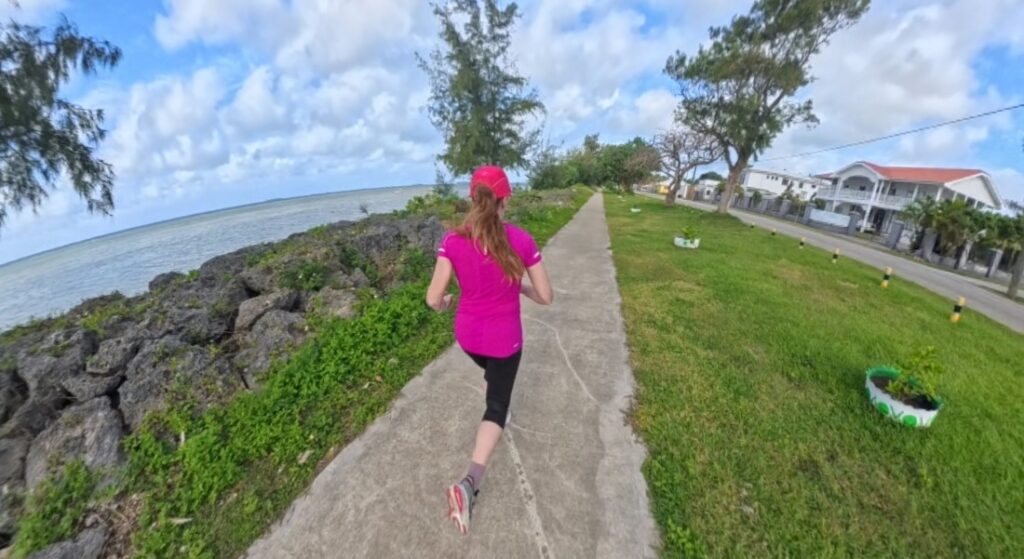Tisleifjorden lake, Norway. March 2022.
Two centuries after Samuel Taylor Coleridge wrote “The ice was here, the ice was there, the ice was all around; it cracked and growled, and roared and howled, like noises in a swound“, in Norway they reimagine the experience in a much more festive way: running on the frozen Tisleifjorden lake.
TLDR; “too long, didn’t read”
- I just want to run! Take me to RACE.
- I have 1 minute. Take me to USEFUL INFORMATION.
- Running is my excuse for travelling. Take me to TRIP.
- Running is my excuse for eating. Take me to CARBOLOADING.
- I want to know what to read in the plane. Take me to ONE BOOK.
🌍 The trip 📷
Oslo
Having bought all the necessary gear for the Polar Circle Marathon, I looked for another challenge in cold climates. And I found the perfect one: a marathon over a frozen lake in Norway! On the organization’s website, Vanilla Ice’s “Ice, ice, baby” was used as a publicity stunt, along with a video of grooved ice rinks zigzagging across a snow-covered lake… how could I resist?
We rented a car from Oslo to get to Hemsedal, about 200 kilometers to the north. Oslo is home to the amazing Edvard Munch museum, but our particular “scream” was articulated when paying the bill for a supermarket where we stocked up on some things we needed. We experienced firsthand that the standard of living in Norway is much higher than that of Spain. Thank you, Norwegian sovereign wealth fund!
Road trip
During the journey, we soon began to see lakes with large patches of ice, although they did not seem safe enough to organize a marathon on their surface… Somewhat distressed about it, we arrived at Hemsedal, where a few reindeer crossed our path; the scene looked like something out of a tourist brochure.
I remember the day the thing blew up […] the spring sun outside, the asphalt no longer snowed, the ice on the Laugen that wouldn’t take long to break.
“The sixteen trees of the Somme” by Lars Mytting
We picked up the runner’s bag at the Golsfjellet Fjellstue, a very “winter resort”-style hotel: their walls were decorated with polar bear skins and there were carvings of trolls in its well-stocked liquor bar. Seeing its wonderful woods, the “Norwegian wood” from Haruki Murakami’s novel came to my mind. Since the writer is also a well-known marathon runner, I imagined him running on the frozen lake… but, spoiler alert: he wasn’t there 🙂

We did not stay at the Golsfjellet Fjellstue, but at the Eikre Fjellgård guest house, which turned out to be one of the highlights of the trip. It’s a cozy family home in whose narrow corridors you find black and white photographs of uncles, cousins and grandparents, a faded velvet armchair, or a sofa with a blanket that looked like Roseane’s. I had the feeling of staying at the Hilsbijer farm from the novel “The Sixteen Trees of the Somme” by Lars Mytting, whose review I include below.
🍜 Carboloading and Protein Recovery 🍝: What to eat
Norwegian cuisine offers a variety of dishes that are high in carbohydrates for carbo loading, as carbohydrates are very important in colder climates to provide energy. Many options dwell around… Potatoes 🥔!! A classic dish made of boiled potatoes with butter and milk is Potetstappe, or Mashed potatoes. There is also a flatbread made from potatoes, flour and milk, and the very popular dumplings, Raspeballer.
On average, a medium-sized potato of about 150g contains approximately 30-35 grams of carbohydrates: and since in Norway there is no tradition to fry them “French fries” stiles, the dishes are much healthier.
For recovery, Norway has you covered with its variety of fishes: its Salmon, world-renowned, as gravlaks (cured salmon) or baked, but aslo Cod, or Herring.
🏃♀️ The race 🏃♂️
I was expecting cloudy skies and grey landscapes, those that shape the well-know nordic stern personalities, but Innlandet and Viken counties were awash with light and unexpected colors; the greens and reds of wood doors and windows, and the vibrant neon colors of runners’ t-shirts, leggings and hats.
We were lucky, because the sun shone during our 3-days trip, and the weather was especially kind to us on the day of the race. Even too benign!, because, with the sun, the lake’s whiteness became hurtful and sunglasses were necessary.

Before the start
Despite the icy landscapes, the Frozen Lake Marathon enjoys a hospitable atmosphere. Perhaps because it is an event limited to 500 runners, but we had the feeling of almost being with family. Everybody smiled, our cheeks red from the icy air, as we put on our spikes. We opted for the solid 16 mm crampons, instead of the much less cumbersome 2-inch ones we used in Greenland. And we made the right choice.
At the start we took a picture of the 80 cms of ice below our feet, with the magical beryl-colored geometries that made up its layers:
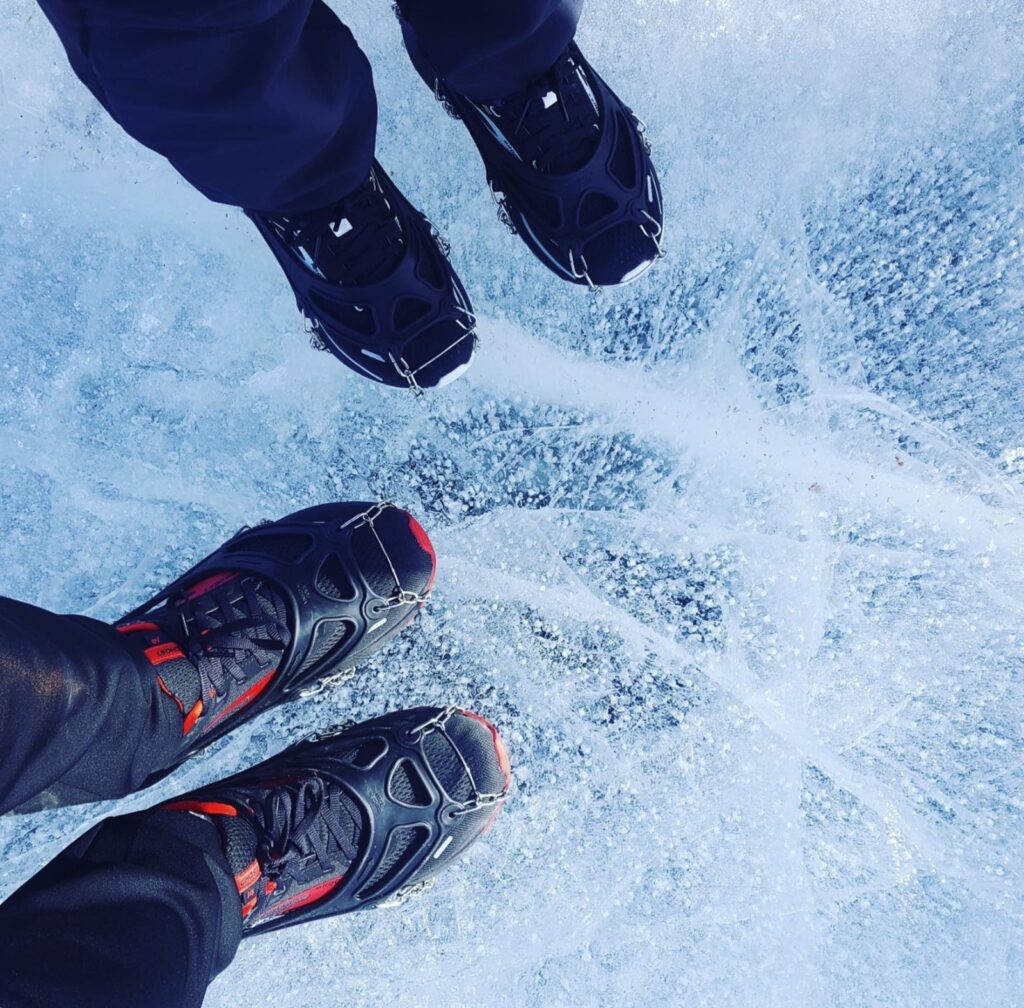
Around us, children waved Norwegian flags and a young reindeer waited patiently near the starting line. Murakami was no there, but there was a Pole who was trying to break a Guinness record; the guy was going up and down pulling a car!
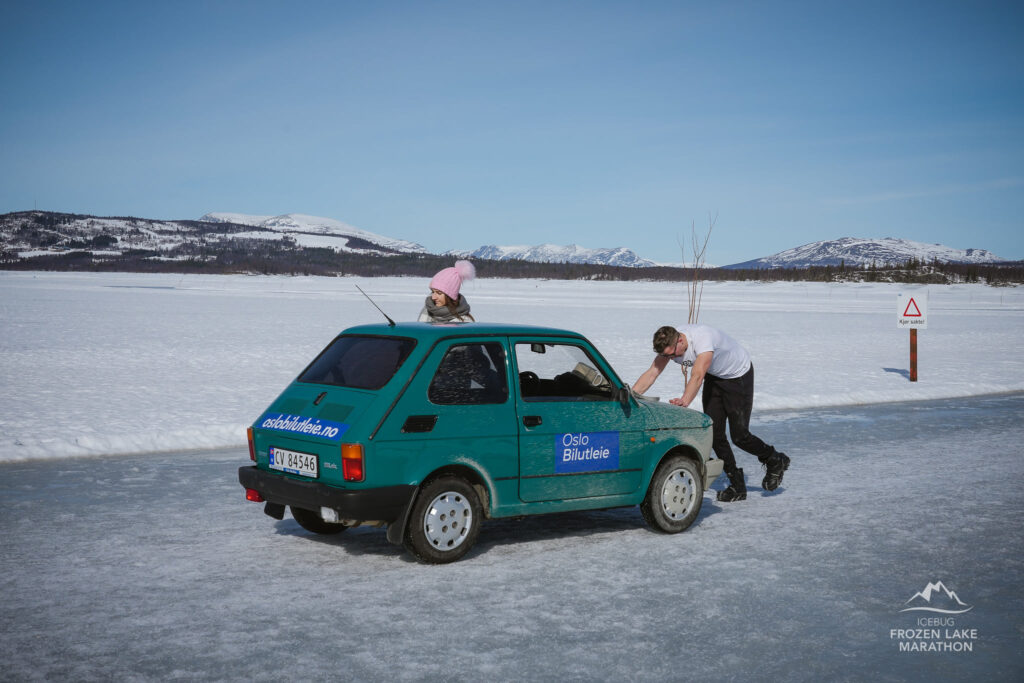
The race
It is not an easy race, because running on ice is very tricky, despite the course being completely flat. The final course layout is not known in advance, as it depends on the state of the ice.
There are no crowds or runners eager to start fast. Except for the most “professional” ones, the rhythm is slow: everybody seems clumsy, running cautiously. The organization had already warned us: here you do not come to set your PB.
There are refreshment stations where they serve water an energy drinks (as cold as the climate) and play some heavy metal songs.
Although we saw a very brave man running barechested, and several sported short sleeves, most runners were perfectly equipped. We had our neck and head properly protected, wore gloves, three layers of clothing for the upper body (including a waterproof / windproof outer layer), pants and inner thights.

Final kms – what a challenge!
The temperature was a few degrees below zero and there was hardly any wind. The spectacular scenery, surrounded by snow-capped mountains, almost made you forget the discomfort of running with crampons. But unfortunately, several sections were starting to deteriorate as we went on: the ice was creaking and melting.
So, for me at least, the last 3 kilometers were particularly difficult. I sank half a leg in a very deceptive patch of melted ice, I stumbled, and I had to run the final part of the race with wet shoes and socks.
It was uncomfortable, despite wearing goretex shoes.
The organization mentions on the website that the times in this race are usually 20% higher than your usual times.
In our case, the predciton was spot on. And when we reached the finish line, we were offered a bowl of a hot soup which seemed to be a complete success amognst the runners!
After the race
In the evening, after the race, our host at the Eikre Fjellgård invited us to grab something to eat in his dining room with the other guests. We tasted some typical food from the area: we ate Norwegian salmon, brunost cheese and cranberry jam. I thought about what Per Pettersen writes in the first pages of “Going Out to Steal Horses”:
…maybe I’ll go to the lake to see if the ice holds…. and then I’ll light the stove and get drunk properly, with a bottle that I keep in the cupboard
“Out stealing horses”, Per Pettersen.
His words almost matched our experience, not only because of the part of the lake and our own doubts about whether the ice would hold, but because of the drinking alcohol next to a stove to warm up 😋.
We finish our adventure talking about the race with a couple of youngster who had travelled from Denmark, and looking at our medal which, naturally, was made of Norwegian wood.

Useful information
🏆 Frozen Lake Marathon (42K) / Half Marathon (21k). First edition: 2018. Number of runners: 500.
⛰️ Difficulty High. The course is totally flat, but very slippery because of the frozen surface of the lake, and the ice is already melting in some sections.
🌐 Website https://frozenlakemarathon.com/
🗓️ End of March at Lake Tisleifjorden, at an altitude of 819 metres, between Gol and Hemsedal, in southeastern Norway, Europe.
👟 Wear waterproof goretex trail shoes. Spikes are necessary, and better to go for the 16m ones. Bring also sunglasses in case it is sunny.
🏅 In the runner’s bag we found a stylish and very comfortable cotton T-shirt, and, upon arrival, in addition to homemade soup cooked on the spot, we got a very cool Norwegian wooden medal.
💰 The price for the marathon in 2022/2023 was NOK 1,500 (EUR 129) and the average price is NOK 1,200 (EUR 102).
The cost of the trip is high since Norway is one of the most expensive countries in Europe.
✅ Very well organized with great merchandising, post-race snacks and a friendly atmosphere.
✅ An original race with a natural environment of exceptional beauty, in a safe and friendly country.
❌ Added to the difficulty of running on ice, there are melting zones. You are not going to do a PB no matter how flat the course is.
❌ Running with spikes is not a great experience.

Map
The race course varies from year to year, as it depends on the state of the ice. It is a 21k lap, or 2 laps for the marathon.
In the website there is a sketch of the 2019 course, which is quite artsy but doesn’t say much.
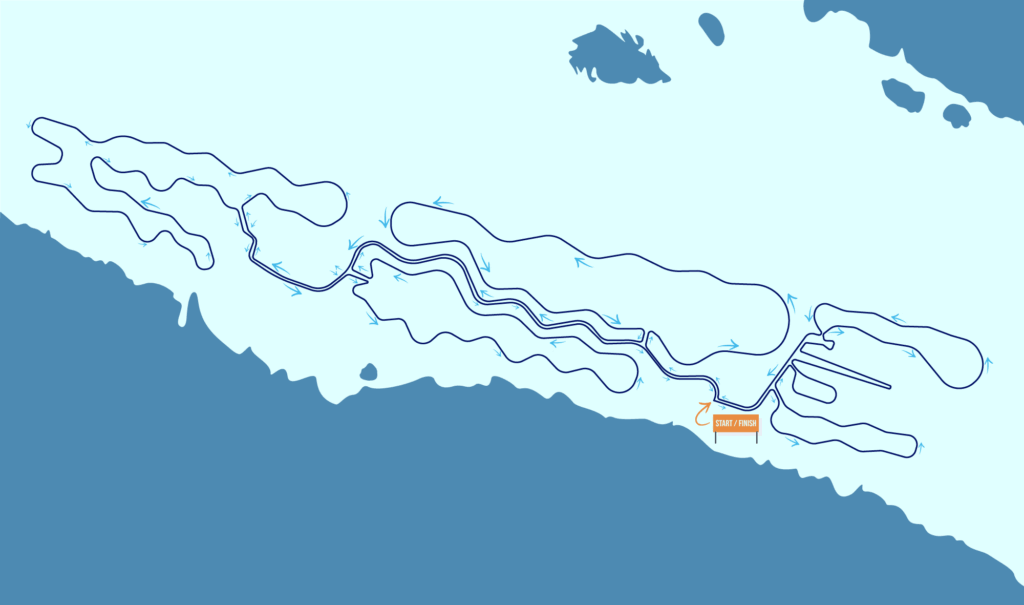
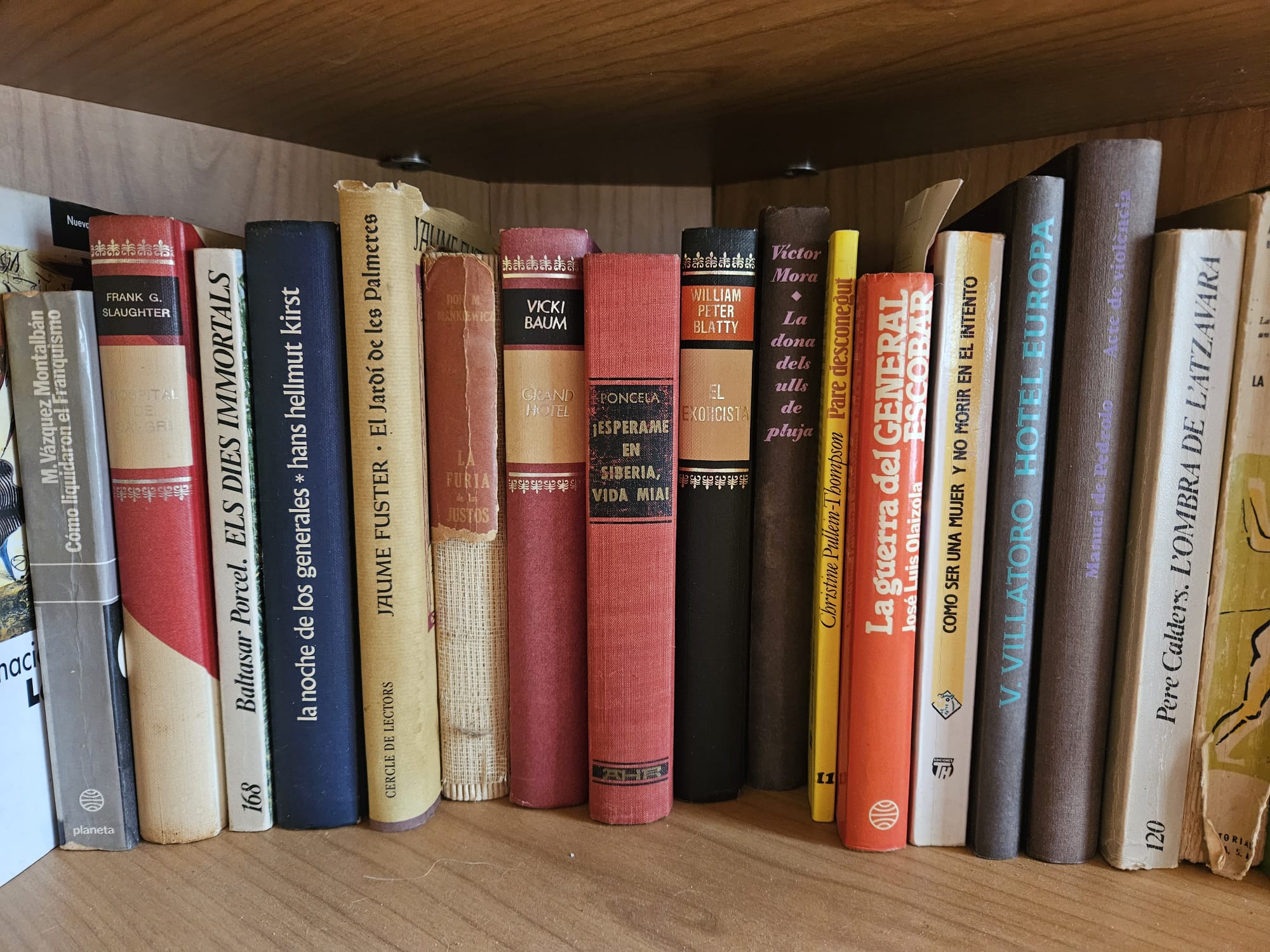
One book
“The Sixteen Trees of the Somme”, by Lars Mytting.
I was fascinated by its story of intimate discoveries that intertwine with those of Norway itself, and that are articulated through wood.
There are anecdotes of great wars and family quarrels, there are carvings of flamed birch trees and shady villages where…
you find the same as anywhere else: the Supply Cooperative, the haberdashery, the post office, the cooperative supermarket, a path that runs above the village where you they clog ambulances and crumbling houses inhabited by people who refuse to pay their taxes
Very similar to what we saw around Hemsedal.

To know more…
| 📖 “The Sixteen Trees of the Somme”, by Lars Mytting 📖 “Out stealing horses”, by Per Pettersen 📖 “A Doll’s House”, by Henrik Ibsen 🎬 Ragnarok, TV series, 2020. |
“A Doll’s house”, by Henrik Ibsen
A masterpiece in his subtlety, when I first read “A Doll’s house”, I was unable to understand the struggles of the main character, Nora. I remember myself, as a young adult raised in the 80s, shouting “Finally!” when Nora defies her husband and the hypocrytical society of Norway at the time.
It took me a while to understand how different society was and how brave the character of Nora is. I loved it, and I realised that this was the same constricted society in which Edvard Munch, one of my favourite artists, created his anguished paintings.
⭐⭐⭐⭐
